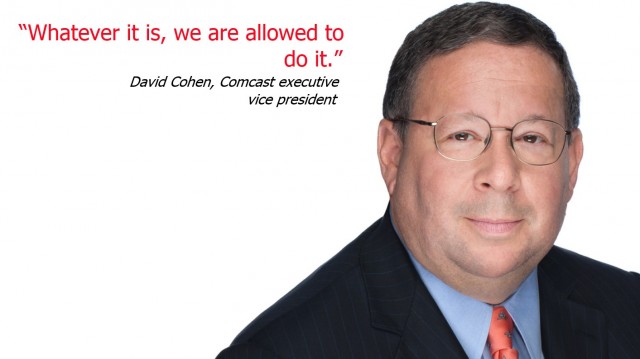
Usage caps for one and all.
Comcast, which insists on placing a 1 TB (1,000 GB) usage cap on most (but not all) of its broadband customers, is predicting explosive growth in broadband usage as customers connect more devices to their internet connections.
“[If] you look at in terms of just overall consumption, just at a high level, you look at the top 10% of our customers, just how much they use, they are using 20 or more connected devices,” said Comcast Cable president and CEO David N. Watson on a company conference call. “And it’s a tremendous amount of consumption that we have. And I think that’s where the market is going. There is going to be more consumption, more connected devices.”
Comcast’s growth forecasts suggest the company schedules regular network upgrades, although it has only adjusted usage allowances three times in the last decade:
- Comcast introduced a 250 GB usage cap in 2008 that carried no overlimit penalty but persistent violators lost their Comcast broadband service.
- Comcast raised the cap 300 GB in 2013 and implemented an overlimit fee.
- Comcast raised the cap to 1 TB in 2016 and began promoting its Unlimited Data Option as an insurance policy against bill shock from overlimit fees.
“It is important to know that more than 99 percent of our customers do not use a terabyte of data and are not likely to be impacted by this plan, so they can continue to stream, surf, and download without worry,” claims Comcast on its website. As of December, 2017, “Xfinity Internet customers’ median monthly data usage was 131 GB per month during the past six months.”
Such claims should make customers wonder why Comcast needs a usage allowance of any kind if these claims are true. A 2016 study suggests Comcast may have more heavy users than it is willing to admit. The research firm iGR found average broadband usage that year was already at 190 GB and rising. There is no third-party verification of providers’ usage statistics or usage measurement tools, but there are public statements from Comcast officials that suggest the company faces a predictable upgrade cycle to deal with rising usage.
A 2016 study suggests Comcast may have more heavy users than it is willing to admit. The research firm iGR found average broadband usage that year was already at 190 GB and rising. There is no third-party verification of providers’ usage statistics or usage measurement tools, but there are public statements from Comcast officials that suggest the company faces a predictable upgrade cycle to deal with rising usage.
“We increase the capacity every 18 to 24 months,” confirmed Watson.
Upgrading is also a crucial part of Comcast’s ability to charge premium prices for its internet service.
“Not all broadband networks are created equal,” Watson said. “If you are providing a better solution in broadband, your pricing can reflect that.”
For Comcast customers using a terabyte or more in a month, after two courtesy months of penalty fees being waived, Comcast will recommend signing up for its Unlimited Data Option, which costs $50 a month. If you do not enroll and exceed your allowance a third time, the company will bill you overlimit fees: $10 for each additional block of 50 GB of usage. The maximum overlimit penalty in any single month is a whopping $200.
Critics of Comcast’s data caps point out that Charter — the nation’s second largest cable operator, has no usage caps at all. Optimum (Altice) also does not impose data caps. Those that do often copy Comcast’s data allowances and overlimit fees exactly — all to deal with so-called “data hogs” that the companies themselves claim represent fewer than 1% of subscribers.


 Subscribe
Subscribe
Could it be caused by the explosive growth in …..Cord Cutting & Video Streaming??
Nope, it’s all about the money they are doing. Data caps are unnecessary. They just use monopoly hoping they are the only ISP in town so they can put profits in their pockets before consumers.